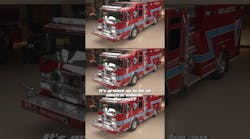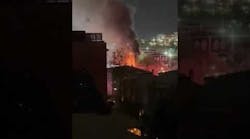Here’s a question for you, the initial incident commander: “What resources do I have to attack and extinguish this fire?” After you answer that question, here’s another one: “Can they get the job done safely or are more resources needed?” Since you have little more than a radio to extinguish the blaze in front of you, first assess how much you need in the way of people, pumpers and water , then do the following very quickly:
1. Deploy your response force as per your operating guidelines.
2. Call for help. Do not be conservative. You can always return units you do not need.
3. Call for the necessary resources to staff both the attack and reserve forces.
4. Pay attention to the operation as it unfolds before your eyes.
5. Make timely decisions.
It is important to have a plan for conducting fireground operations before they happen. Work on this with your crew by pre-planning locations in your district and planning your attack. To accomplish this, you must develop a personal understanding of your fire department’s deployment strategy. You must have a definite deployment plan if you are to do your job correctly. To do this, your department must develop “general operating guidelines” (“GOGs”) to use in directing your emergency operations. Your guidelines should define what fire companies are expected to do, not how they are to do it.
This is an important distinction in well-written GOGs. As a part of these guidelines, your department should indicate the tasks, duties and responsibilities of the various units that respond on an alarm. The tasks should be loosely defined so units are not trapped into doing the wrong things. You want to offer guidance, not tie people’s hands. To develop well-written guidelines, determine what fire department resources you need to safely protect your community. I’m not here to teach municipal master planning, but that same methodology can form the basis for your deployment strategy.
Incident commanders (and you will be one from time to time) must be able to look at a fire scenario as it unfolds. They must be able to assess the fire’s development and quickly judge the potential requirements for apparatus and personnel. A wealth of information exists that can help you determine the resource needs for a firefighting operation.
Fireground command skills come with experience and training. You must learn to balance the resources you have against the demands of the situation. And you must be flexible as things play out. There are a range of deployment options, but you are the one who must make the critical decisions under fire. Once you have decided the level of resources needed in a particular situation, another contingency must be addressed: You must maintain an on-scene reserve force to handle sudden, additional needs.
Experience has taught me it is always better to call for help before you actually need it. For example, suppose you decide you can handle a structural fire attack with two engines and a truck. To provide an additional margin of protection, it would be good to summon an additional engine and truck for standby. If needed, they are available; if not, they can return to service. By doing this, you will be ready for any unforeseen circumstances.
How do you learn to deploy your forces and summon reserves and added assistance? The best way is through experience, supplemented by training. Fire officers can improve their learning curve through the use of structured training. What else can you do? Read about firefighting. Train in conducting firefighting operations. Hold drills and respond to actual fires, then conduct critiques and apply the lessons learned to your training programs. This way, you will become skilled in delivering the forces at your disposal in an effective manner. More important, you will know when to call for help. And you will do it in a rapid-fire manner.
Begin to think numerically when looking at a fire building. Do not limit your view to smoke and flames, but look for numerical needs. For example, in addition to thinking about construction, location and volume of fire, think of attack-force size. Also learn to estimate structure sizes. Look at a building, estimate its size, then arrange your personnel and apparatus response based on your needs assessment. In this way, your mind lets you create the resource estimates that form your decision base. You can then request and deploy an adequate force to stop the fire.
Your job as the person riding the right-front seat is to maximize the effectiveness of your team. Know what you can do and what you can’t do. The more time you devote to preparing, the better will be the outcome when things start to cook.
“Know it before you need it” is a good motto. Be serious. Train hard. Be smart. People’s lives are in your hands.






